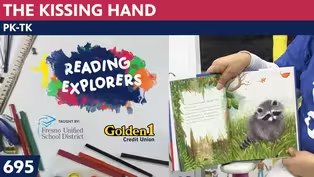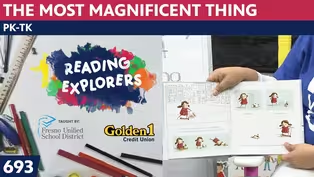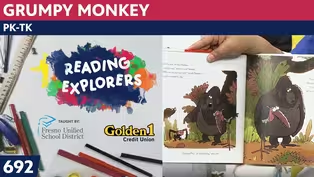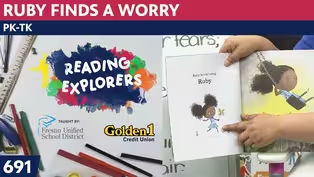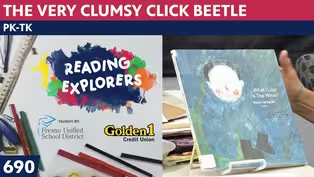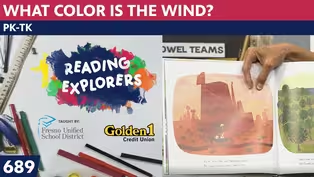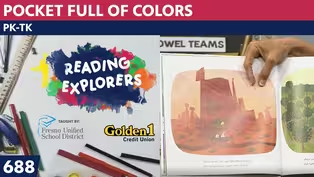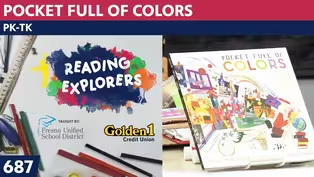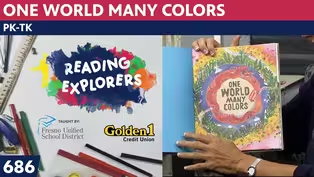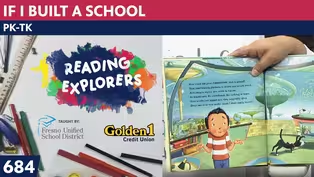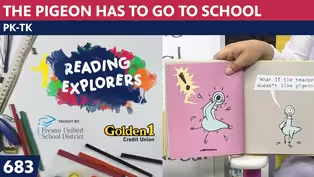
TK-382: John James Audubon
Season 3 Episode 463 | 14m 5sVideo has Closed Captions
Join Mrs. Readwright at Camp Discovery!
Transitional Kindergarten teacher, Mrs. Readwright, welcomes students back to Camp Discovery, a fun learning space packed with reading adventures & fun games!
Problems playing video? | Closed Captioning Feedback
Problems playing video? | Closed Captioning Feedback
Reading Explorers is a local public television program presented by Valley PBS

TK-382: John James Audubon
Season 3 Episode 463 | 14m 5sVideo has Closed Captions
Transitional Kindergarten teacher, Mrs. Readwright, welcomes students back to Camp Discovery, a fun learning space packed with reading adventures & fun games!
Problems playing video? | Closed Captioning Feedback
How to Watch Reading Explorers
Reading Explorers is available to stream on pbs.org and the free PBS App, available on iPhone, Apple TV, Android TV, Android smartphones, Amazon Fire TV, Amazon Fire Tablet, Roku, Samsung Smart TV, and Vizio.
Providing Support for PBS.org
Learn Moreabout PBS online sponsorshipMore from This Collection
Valley PBS and Fresno Unified School District have partnered with Golden 1 Credit Union to create Reading Explorers Lessons for grades Pre-Kindergarten through Third grade. The daily lessons will be taught by Fresno Unified School District teachers and are created to help students practice their reading skills and reinforce lessons during distance learning.
Video has Closed Captions
Valley PBS presents Reading Explorers Lessons for Pre-Kindergarten and TK. (26m 27s)
PK-TK-693-The Most Magnificent Thing
Video has Closed Captions
Valley PBS presents Reading Explorers Lessons for Pre-Kindergarten and TK. (26m 26s)
Video has Closed Captions
Valley PBS presents Reading Explorers Lessons for Pre-Kindergarten and TK. (26m 28s)
Video has Closed Captions
Valley PBS presents Reading Explorers Lessons for Pre-Kindergarten and TK. (26m 28s)
PK-TK-690: The Very Clumsy Click Beetle
Video has Closed Captions
Valley PBS presents Reading Explorers Lessons for Pre-Kindergarten and TK. (26m 22s)
PK-TK-689: What Color is the Wind?
Video has Closed Captions
Valley PBS presents Reading Explorers Lessons for Pre-Kindergarten and TK. (26m 21s)
PK-TK-688: Pocket Full of Colors
Video has Closed Captions
Valley PBS presents Reading Explorers Lessons for Pre-Kindergarten and TK. (25m 58s)
PK-TK-687: Dancing Through Fields of Colors
Video has Closed Captions
Valley PBS presents Reading Explorers Lessons for Pre-Kindergarten and TK. (26m 20s)
PK-TK-686: One World Many Colors
Video has Closed Captions
Valley PBS presents Reading Explorers Lessons for Pre-Kindergarten and TK. (27m 13s)
PK-TK-685: School is Wherever I am
Video has Closed Captions
Valley PBS presents Reading Explorers Lessons for Pre-Kindergarten and TK. (26m 32s)
PK-TK-684: If I Built a School
Video has Closed Captions
Valley PBS presents Reading Explorers Lessons for Pre-Kindergarten and TK. (26m 21s)
PK-TK-683: The Pigeon Has to Go to School
Video has Closed Captions
Valley PBS presents Reading Explorers Lessons for Pre-Kindergarten and TK. (26m 22s)
Providing Support for PBS.org
Learn Moreabout PBS online sponsorship♪ Good morning to a brand new day ♪ ♪ Time to learn and games to play ♪ ♪ Learning things is so much fun ♪ ♪ Learning is good for everyone ♪ (soft music) - Hello early learners, and welcome back to the art room.
You know we're learning more about birds and John James Audubon.
You'll hear a lot about him because teachers really understand that he was the father of bird study, and they may bring in pictures that he's done, and I brought one today.
Let's do a quick hello, nice to see you everyone.
♪ Hello, nice to see you everyone ♪ ♪ Hello, nice to see you everyone ♪ ♪ Hello to you ♪ ♪ Hello to you ♪ ♪ Hello to you ♪ ♪ Hello to me ♪ ♪ Hello, nice to see you everyone ♪ Well, John James Audubon, we learned yesterday went to military school when he was 12 'cause his daddy wanted him to be in the military or the army.
But when he was there in that school, he didn't like it.
They didn't allow him just to walk around and look at birds and draw birds and talk about birds and come into the house excited about birds and tell people about birds.
And when he was an adult though, he did lots and lots of sketches of birds.
And one time he went away for a while.
And when he came back, 200 of his drawings had been nibbled up by rats.
He had left them in a place where the rats could get in there, and they didn't have as many things that kept rats away from their houses.
And they would just come in and act like they lived there, and they ate up his drawings.
So he had to do more and more and more drawings and took them to England where there were people there who loved his work.
And I will tell you more about it because it has something to do with a million dollars, and I'll tell you about it tomorrow.
But today, in January, I was looking on the internet and across my page came drawings done by a nine year old.
And I didn't know if it was a boy or a girl, but I loved their work.
And if you send me work, you know that I always write back and tell you the things I like about it, or what I thought you did well.
And I wanted to write to him or her and tell them how much I enjoyed the drawings, because I really love birds.
And this person went to a bird identification book and looked at what the birds looked liked, used the right colors, and made their own identification book.
I cut off most of the words just so that you could see how big the drawing was when we look at the art you'll see.
I did want to tell you though, yesterday I forgot to play the bird song of my favorite bird and listen to it.
(bird chirping) That bird calls out that song over and over again.
And we'll hear it again later.
But today we're going to talk about the tree swallow.
Oh, stop singing bird.
The tree swallow is the bird that I really wanted to put on some kind of clothing by painting the way that the boy or girl painted.
Oh, I should finish the story.
When I went to the parents and wrote to them, the dad works for television and he said that he would interview his child and send it to me.
I said, is it a boy or a girl?
And he told me it was a boy.
So, but the dad said, no, he didn't think he was ready to put his boy on television.
So, we just have to wait, but I want you to see his work.
I found a photograph of a tree swallow of the real bird.
And it looks like that's the one that our friend drew and used the colors when he did his drawing.
And you can see he used some dark on the wing at the shoulder, lighter at the top of its head.
There's a little bit of brown on the back.
There's white on its chest.
It had a little dark place on the chest and a black beak.
So we're going to do this.
And when I asked the parents, what kind of paper did they use?
And they said a brown paper bag.
Just like I tell you that is a good piece of paper to keep and use.
So let's bring down this picture.
We'll get rid.
Oh, I'm going to have to stand up boys and girls because this paper is small and it's really clamped in here.
We'll take this down and put it as our inspiration, not only the real bird, but the bird that this tree swallow that the child drew.
So let's get this set up, and I'll turn it to you while I get my piece of brown paper.
Just a brown bag.
That's all it is.
And I got together, I got into all my colored pencils and I got out all the blues that I had.
There's not a single one that repeats itself here, they're all here.
I got white and gray, and I did get a black for the beak, and we'll be ready to start that.
I got two different sizes because I wondered how long would it take me to make this bird and finish it in one sitting.
So maybe I'll just use this small piece.
I hope I'm not sorry.
But we wanted to do the same kind of drawing like we did yesterday when we drew around and made the oval for the body, make the tail feathers.
In these, the tail feathers kind of go just out under the wing feathers go way back off of its back.
So here I'm going to draw the oval for the body.
Then I will draw a head circle here.
And that way we'll be able to see which way the bird is going to be placed.
So let me start out.
If you want to use a regular pencil, I'm going to use my white pencil and make the oval.
I'm doing it lightly so that when I go to color it, it will not have the connecting lines.
There's its head.
And I'll put its little beak on here so I remember it's just a small black beak.
I'm going to put the wing from the shoulder down and passed the tail.
And then there's a little place on its back, and then I'll make the tail feathers go back here.
Now I know that you will have a hard time seeing this, so I'm going to use my dark colored pencil just to get started, or maybe I'll start with its chest.
Because under its face, and I'm just putting.
This is how they did it, they just press it down, and did little hatch, hatch, hatch, hatch, hatch.
And you just go in a row 'cause that's how feathers are.
And so I'm just going, meeting the other one.
Now I'm doing a little overlap.
Do you see this?
Does it show up?
I think it does.
So I'm doing more feathers down its body, still going all the way down, and even into part of where the tail connects.
And I like starting from the top and overlapping my feathers, so there's not a lot of paper that will show through.
So I'm doing this feathering, feathering.
And it has a little bit under its face.
So I'll do this, it has like a little right under its eye, maybe I'll do its eye so that we can see exactly where we need to go for space.
Is this the black?
Yes.
So it has a little black eye right here.
It's just a round dot.
And then I'll make its beak, so you can see where its face ends.
The lower part of its face from the beak down is white, and a little bit right below the eye has some blue feathers, but it's mostly white on its face.
So now I'm going to start using some of this blue, and I'll go around the outside so you can see.
When it hits its neck, I'm going to use a different color blue so you can kind of see where the head meets the neck.
Notice that I'm just using my pencil up and down, up and down, up and down, doing little hatches, hatch, hatch, hatch, just like they're little teeny tiny feathers.
Excuse me, I have a little crack in my voice.
I'm just doing lots of little feathery marks.
If you like coloring it in like it's a color book, you can.
But I think it looks better if you want it to be an inspiration from this little boy who did this art.
Now at the top of their shoulder of their wing is a dark, dark color.
And then it goes into a lighter color.
I had this kind of periwinkle blue that I think will be good for the shoulder back.
And I'm drawing this so that you can see that the wing feather goes wing feather, wing feather, wing feather, wing, and I can go around it and make it go feather, feather, feather.
Same thing.
On this feather, he has some gray on his wing.
I'm going to do a little gray, just outlining the very end of it.
Let me turn it up so you can see what I'm talking about.
Right here, I'm drawing like its fingernails putting at the end like that.
And it's kind of grayish.
Excuse me, boys and girls.
That long wing feather goes down below, 'cause there are some smaller ones there.
Then you can just keep doing your feathers.
If you want it to look like the bird in the bird book, then just do the colors like light blue and dark blue together.
Make it look beautiful, that's what I think.
And this is something that you can practice.
And every time you do a bird, you get better at drawing the body.
I know that when I practiced, I thought, oh no, I made that too chubby.
And the birds, they look bigger than they are because they have such puffy feathers.
And you can mix them up.
Like right now I'm mixing my dark blue with that light blue, 'cause I think I need to do that to make it look more realistic.
Now you'll see I'm going to turn it toward myself so I can see it.
Now these wing feathers that are the flight feathers, they're more silky, and that's where they preen, or they use their beak and they bite bite bite.
You think, why are you biting herself?
But that's how they move a little oil over their feathers so that they won't be dirty.
'Cause when they try and fly, their wings have to be strong to carry their whole body as they're flying.
So when you see them putting their head down and nibbling on their feathers, that they're getting any dirt pieces out or any little bugs that might've flown into them when they were flying, because they have to share the airspace with bugs.
I'm using, look how I'm turning my pencil on its side.
I'm filling in any places that I don't want the paper bag to show.
I'm not pressing hard though.
I'm just kind of shading.
And same that I'm going to do on its head.
I'm shading it in like that.
Now, I'll do a little bit, I don't need black on this.
Although, on the tail feathers, they have kind of an outline that you might like, and I'm going to put its legs forward like Charlie Harper taught us with three toes in front, and one in back.
Three toes in front, and one in back.
I don't have a stick for it to stand on yet, but that might be something I will add.
And again, these are the feathers that are a little smoother, so I'm going to put myself on like this and color it in a little bit like that.
Now I can go back in with my white, and make sure that I have all the feathers on his face and body like this.
Boys and girls, I hope you'll make some birds and send me what you've done.
And if you send it to the studio, we can send you one of those activity books that the station bought for children who participate in the show, and you can send it to us.
Now it looks like he's just standing there, but I think that he looks pretty good so far.
And I can add the background to it.
I won't paint it though, I think that maybe I'll write down tree swallow like the little boy did here on his tree swallow.
All right.
So we did a lot of colored pencil work today.
I wonder if that's the tool you used.
Now remember, if you use a tool that's different from mine it's just fine.
Now, we're going to do another bird tomorrow, and I will let you hear its sound, and show you what it looks like.
So join me tomorrow, bring your coloring tools and paper.
I'll see you tomorrow boys and girls.
Bye-bye.
♪ Good morning to a brand new day ♪ ♪ Time to learn and games to play ♪ ♪ Learning things is so much fun ♪ ♪ Learning is good for everyone ♪
Support for PBS provided by:
Reading Explorers is a local public television program presented by Valley PBS
